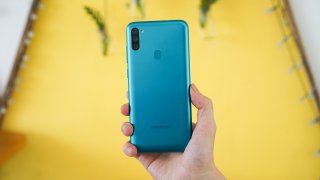Samsung Galaxy M11

- 6.4" 720x1560 pixels
- 13MP 1080p
- 3/4GB RAM Snapdragon 450
- 5000mAh Li-Ion
Phone Finder
- Acer alcatel Allview Amazon Amoi Apple Archos Asus AT&T Benefon BenQ BenQ-Siemens Bird BlackBerry Blackview BLU Bosch BQ Casio Cat Celkon Chea Coolpad Cubot Dell Doogee Emporia Energizer Ericsson Eten Fairphone Fujitsu Siemens Garmin-Asus Gigabyte Gionee Google Haier HMD Honor HP HTC Huawei i-mate i-mobile Icemobile Infinix Innostream iNQ Intex itel Jolla Karbonn Kyocera Lava LeEco Lenovo LG Maxon Maxwest Meizu Micromax Microsoft Mitac Mitsubishi Modu Motorola MWg NEC Neonode NIU Nokia Nothing Nvidia O2 OnePlus Oppo Orange Oscal Oukitel Palm Panasonic Pantech Parla Philips Plum Posh Prestigio QMobile Qtek Razer Realme Sagem Samsung Sendo Sewon Sharp Siemens Sonim Sony Sony Ericsson Spice T-Mobile TCL Tecno Tel.Me. Telit Thuraya Toshiba Ulefone Umidigi Unnecto Vertu verykool vivo VK Mobile Vodafone Wiko WND XCute Xiaomi XOLO Yezz Yota YU ZTE
Samsung Galaxy M11 Summary
In the past few years, low-cost phones have been gradually perfected to bring more experiences to consumers at lower prices. However, in a certain way, the devices in the segment around Rs. 10,000 still carry inherent weaknesses in terms of build quality or battery life or fast charging. The main character in this review is Galaxy M11- A Rs. 10,999 device that overcomes many shortcomings of products of the same price range.
The handset is announced in June 2020, alongside the more affordable Galaxy M01. Compared to other phones in the segment, the Galaxy M11 is a decent option, but you will get much more by spending Rs. 2-3,000 more to purchase the Redmi Note 9 Pro or Realme Narzo 20.
Samsung Galaxy M11: Design
In this price segment, the M11 has a good design. Not an excellent, outstanding, eye-catching one, but a good design for a regular user. Although the Galaxy M11 is not as eye-catching as some other products with a gradient glass back at the same price, but in return, it gets a much curved design as well as a sturdy and compact body.
Samsung Galaxy M11: Display
The Galaxy M11 has a modern front with the hole punch style. At the moment, it is one of the cheapest products you can buy with a punch-hole display. With a tiny cut-out placed at the left corner and thin bezels, the overall front panel of the product looks much better and more premium than its predecessors. However, in terms of the display quality, the 6.4-inch HD+ TFT screen of the M11 is not so good. The maximum brightness of this screen is average while colors are a bit pale and viewing angles are narrow.
With a TFT LCD panel, you should not expect to have the best entertainment experience. However, with a 6.4-inch display, it is still large enough to enjoy watching movies or playing games, but the display quality isn’t as good as what AMOLED panels offer.
Samsung Galaxy M11: Camera
Compared to Galaxy M10, M11 is upgraded with three rear camera lenses, including a 13MP main camera, a 5MP ultra-wide-angle camera, and 2MP depth sensor. Meanwhile, there is a single 8MP camera on the front for picturing selfies and video calls. It is worth noting that the liveview of the camera is quite bad, so the image after being taken and processed will be much better. The overall image quality of the device is expected for a phone at Rs. 10,000 price range. It is enough for basic needs, but is quite disappointing when it comes to low-light photography.
In comparison, the Redmi Note 9 gets a 48MP quad-rear camera, which should be much better than that of the M11. The handset's camera setup seems to have better specs than the Narzo 10A or Narzo 20A, but the difference is minimal and those two Realme phones have better and newer chipset, so their image processing capacilities could boost the image quality.
Samsung Galaxy M11: Performance
Hardware configuration is not something the Galaxy M11 shines. With the 3-year-old Snapdragon 450, you can already know how weak this phone is. The device is available in two memory configurations, 3GB RAM + 32GB storage and 4GB RAM + 64GB storage. With basic tasks like surfing social networking, reading newspapers, watching YouTube videos, the device runs smoothly and pretty stably. However, because of the low amount of RAM, you need to clear the apps regularly and restart the device after a few days.
The entry-level Snapdragon 450 is no longer too powerful in 2020 but still enough to play COD: Mobile. If you want to play PUBG Mobile, you better off purchasing another phone. Compared to its rivals, it is quite disappointing that the Galaxy M11 gets a 3-year-old budget chipset. The Realme Narzo 20A that launched earlier in the month is priced at Rs. 8,499, but comes with a mid-range Snapdragon 665. Even the Redmi Note 9 or the Narzo 10A come with an Helio G35, which is less powerful than Snapdragon 665, but it still a newer and certainly more powerful chipset.
Samsung Galaxy M11: Battery life
The battery is the highlight of the phone as it gets a massive 5,000 mAh capacity in a very neat body. Even though Galaxy M11 is not the only product with a 5,000 mAh battery in the price segment, it is the most compact and optimized product. Because as we all know, with larger battery products, the body will often be too thick and bulky.
With a 5,000 mAh battery, the phone lasts for a long time, which is contributed by three main factors: the high 5,000mAh capacity, energy-efficient Snapdragon 450 chipset, and One UI 2.0 offering good battery optimization features.
The total screen-on time of the Galaxy M11 is about 8-10 hours. This number will vary depending on the usage of each person, but it is still better than its competitors.
In addition, the M11 supports 15W fast charging technology - a feature that is missing on other competitors. Even the newly-released Narzo 20A only supports 10W charging standard. Therefore, you won’t have to wait that long to fully charge this phone like it does on other phones.
Samsung Galaxy M11: Verdict
Overall, Galaxy M11 is not too impressive in terms of design, hardware configuration, or camera compared to recently launched products. But what this product brings to users is: a beefy battery, fast charging, good finishing and smooth experience.
I would not say the Galaxy M11 is the best option you can get in the segment. There are multiple better choices like Narzo 10A, Narzo 20A, Redmi Note 9, and more. However, the Samsung Galaxy M11 is still worth grabbing for those who doesn’t care much about performance and need a compact phone with long battery life.
Samsung Galaxy M11 Full Specifications
- Technology GSM / HSPA / LTE
- 2G bands GSM 850 / 900 / 1800 / 1900 - SIM 1 & SIM 2
- 3G bands HSDPA 850 / 900 / 1900 / 2100
- 4G bands 1, 2, 3, 5, 7, 8, 20, 28, 38, 40, 41
- Speed HSPA 42.2/5.76 Mbps, LTE-A
- Announced 2020, March 30
- Status Available. Released 2020, May 4
- Dimensions 161.4 x 76.3 x 9 mm (6.35 x 3.00 x 0.35 in)
- Weight 197 g (6.95 oz)
- Build Glass front, plastic back, plastic frame
- SIM Dual SIM (Nano-SIM, dual stand-by)
- Type PLS TFT capacitive touchscreen, 16M colors
- Size 6.4 inches, 100.5 cm2 (~81.6% screen-to-body ratio)
- Resolution 720 x 1560 pixels, 19.5:9 ratio (~268 ppi density)
- OS Android 10; One UI 2.0
- Chipset Qualcomm SDM450 Snapdragon 450 (14 nm)
- CPU Octa-core 1.8 GHz Cortex-A53
- GPU Adreno 506
- Card slot microSDXC (dedicated slot)
- Internal 32GB 3GB RAM, 64GB 4GB RAM
- eMMC 5.1
- Modules 13 MP, f/1.8, 27mm (wide), 1/3.1", 1.12µm, PDAF 5 MP, f/2.2, 14mm (ultrawide) 2 MP, f/2.4, (depth)
- Features LED flash, panorama, HDR
- Video 1080p@30fps
- Modules 8 MP, f/2.0, (wide)
- Features HDR
- Video 1080p@30fps
- Loudspeaker Yes
- 3.5mm jack Yes
- WLAN Wi-Fi 802.11 b/g/n, Wi-Fi Direct, hotspot
- Bluetooth 4.2, A2DP
- GPS Yes, with A-GPS, GLONASS, GALILEO, BDS
- Radio FM radio
- USB 2.0, Type-C 1.0 reversible connector
- Sensors Fingerprint (rear-mounted), accelerometer, proximity
- Non-removable Li-Ion 5000 mAh battery
- Charging Fast charging 15W
- Colors Black, Metallic Blue, Violet
- Models SM-M115F, SM-M115F/DSN
Samsung Galaxy M11 News

Mobile - Nov 04, 2020
Samsung Galaxy M12 With A 7,000mAh Battery Spotted In Live Photos

Mobile - Jun 03, 2020
Samsung Galaxy M11, Galaxy M01 Unveiled In India, Price Starts At Rs. 8,999

Mobile - May 27, 2020
Galaxy M01 & Galaxy M11 To Launch In India Next Week; Specs Leaked

Mobile - Mar 30, 2020
Samsung Galaxy M11 Unveiled: Triple Rear Cameras & 5,000mAh Battery

Mobile - Mar 14, 2020





